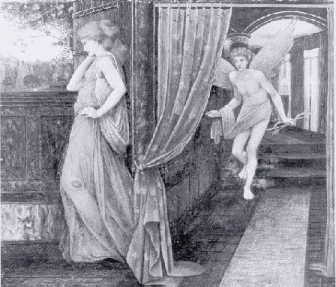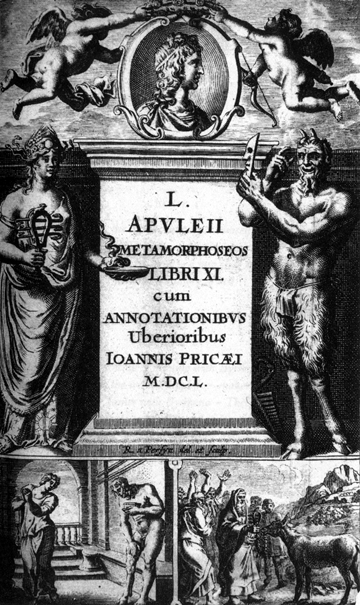Though the two stories at first glance may not seem to have all that much in common, Cupid and Psyche is the earliest known story that influenced the Animal Bridegroom tales which evolved over time and culture to become the story we know today as Beauty and the Beast. Learning the oral versions that came in between helps you see the progression.
The plot:
Psyche is so beautiful she becomes famous and makes the god Venus jealous. Venus gives Psyches' father a prophecy that Psyche must be set on a rock and wed a Serpent. Psyche goes bravely, only to find herself in an exquisite palace where she recieves all sorts of luxuries. A lover comes to her at night, whom she is forbidden to see.

Naturally, any prohibition in fairy tales is violated, so Psyche does look on her husband, after her sisters convinced her she must be married to a monster. Turns out her husband was Cupid, the son of Venus, who was sent to kill her but fell in love instead (woops). Because she looked, Cupid is sent away and Psyche is sent to fulfill many dangerous/impossible tasks by Venus before she can be reunited with Cupid.

Illustration by Errol Le Cain
The story of Cupid and Psyche is found within the larger work Metamorphosis, or The Golden Asse, by Lucius Apuleies, from the 2nd century A.D. Psyche's tale is told as a story within a story, which reflects the larger frame story. This is important, because Psyche's big sin in the tale is curiosity. The pattern in fairy tales is for women to be severely punished for their curiosity while men are often rewarded (think Bluebeard). Yet, this story is a parallel to the narrator of the larger story, Lucius (probably Apuleius himself), who was too curious about magic and ended up accidentally turning himself into a donkey. So this time, the curiosity is not reprimanded only in females. Yet, Benjamin Slade points out that even though the two characters suffer from their curiosity, they are both rewarded in the end. (You could argue the same about Bluebeard's wife, but not her predecessors).

So in this tale we have the precedent for the selfish sisters, and though the groom turns out not to be an actual animal, don't they all in the end turn out to be princes in disguise? Other elements of the story that were weeded out eventually include the violition of the prohibition to look on the husband, and that was often replaced by the prohibition of staying home too long, because of mean sisters/mothers as well. The series of tasks the heroine must go through disappeared by the Villeneuve/Beament version but are still there in some other versions.
Note that, although this is the first known version, it's not the authoritative. This was (likely)based off of earler work by Lucius of Patrae, which is based off of earlier oral stories... maybe this is what Disney meant by "Tale as old as time."
An EXCELLENT retelling of this story is C.S. Lewis' Till We Have Faces. My personal favorite of C.S. Lewis, he tells the tale from the perspective of the sister, but with some twists--the sister doesn't pressure Psyche to violate the prohibition out of jealousy, but out of genuine concern. The main character, Orual, is incredibly ugly, as opposed to Psyche's overwhelming beauty, but not evil. The book is a fascinating look into trust, beauty vs. ugliness, and different forms of love.

Very interesting to read :)
ReplyDeleteThanks!
Cupid At Psyche Buod